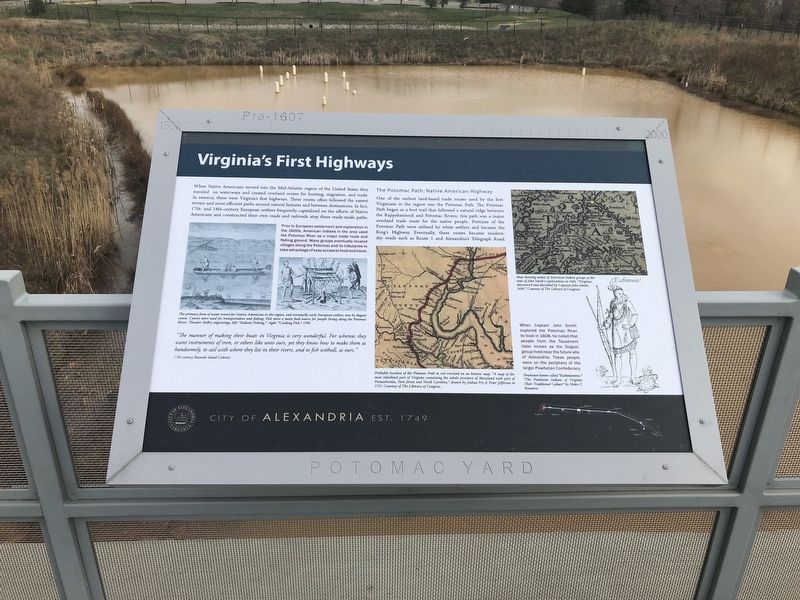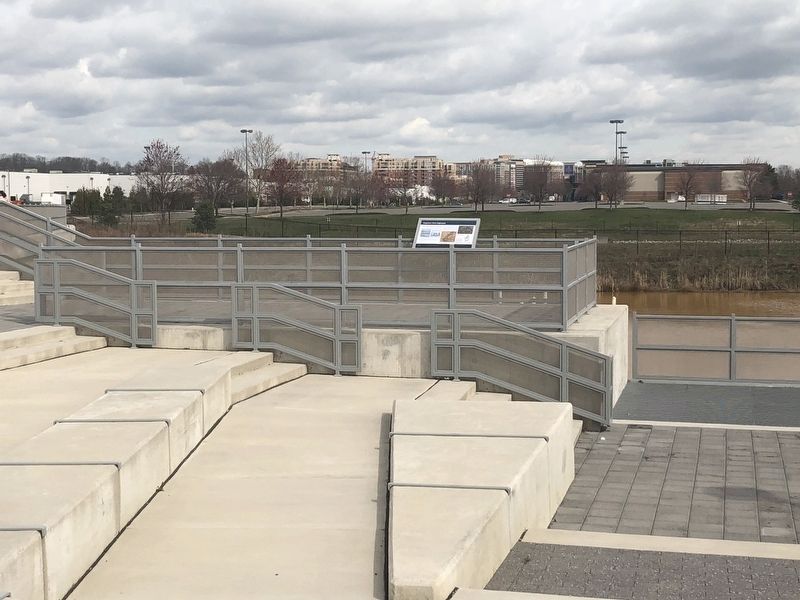Potomac Yard in Alexandria, Virginia — The American South (Mid-Atlantic)
Virginia's First Highways
City of Alexandria Est. 1749
— Potomac Yard —
When Native Americans moved into the Mid-Atlantic region of the United States they traveled on the waterways created overland routes for hunting, migration, and trade. In essence, they were Virginia's first highways. These routes often followed the easiest terrain and most efficient paths around natural features and between destinations. In fact, 17th- and 18th-century European settlers frequently capitalized on the efforts of Native Americans and constructed their own roads and railroads atop these ready-made paths.
Prior to European settlement and exploration in the 1600s, American Indians in the area used the Potomac River as a major trade route and fishing ground. Many groups eventually located villages along the Potomac and tributaries to take advantage of easy access to food and travel.
"The manner of making their boats in Virginia is very wonderful. For whereas they want instruments of iron, or others like unto ours, yet they know how to make them as handsomely, to sail with where they list in their rivers, and to fish withal, as ours.
17th-century Roanoke Island Colonist
The Potomac Path: Native American Highway
One of the earliest land-based trade routes used by the first Virginians in the region was the Potomac Path. The Potomac Path began as a foot trail that followed a natural ridge between the Rappahannock and Potomac Rivers; this path was a major overland trade route for the native people. Portions of the Potomac Path were utilized by white settlers and became the King's Highway. Eventually, these routes became modern-day roads such as Route 1 and Alexandria's Telegraph Road.
When Captain John Smith explored the Potomac River by boat in 1608, he noted that people from the Tauxenent (later known as the Dogue) group lived near the future site of Alexandria. These people were on the periphery of the larger Powhatan Confederacy.
Erected by City of Alexandria.
Topics and series. This historical marker is listed in these topic lists: Native Americans • Roads & Vehicles • Settlements & Settlers • Waterways & Vessels. In addition, it is included in the Virginia, The City of Alexandria series list.
Location. 38° 50.003′ N, 77° 2.856′ W. Marker is in Alexandria, Virginia. It is in Potomac Yard. Marker is on Potomac Avenue north of East Glebe Road, on the right when traveling north. The marker stands in the Potomac Yard neighborhood of Alexandria. Touch for map. Marker is at or near this postal address: 2501 Potomac Avenue, Alexandria VA 22305, United States of America. Touch for directions.
Other nearby markers. At least 8 other markers are within walking distance of this
Credits. This page was last revised on January 27, 2023. It was originally submitted on March 30, 2018, by Devry Becker Jones of Washington, District of Columbia. This page has been viewed 254 times since then and 33 times this year. Photos: 1, 2. submitted on March 30, 2018, by Devry Becker Jones of Washington, District of Columbia. • Bernard Fisher was the editor who published this page.

